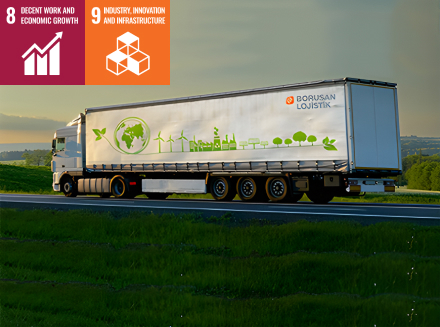Innovation
Our sustainability goal with an innovation focus is to redesign our processes innovatively using a lean approach and technology, aiming at reducing operational risks and ensuring effective and efficient use of resources and workforce. Therefore, we started to focus on our processes, identifying current workflows and manual process steps, and created our digital roadmap. In addition to the Back Office Automation and RPA transformation projects in our Digital Roadmap, programs such as Route – Load Planning and Optimization, Order and Vehicle Tracking Program contribute to sustainability in the innovation dimension by taking process efficiency to the next level.
As part of the goal to centralize data into the decision-making process, highlights include Operational Dashboards for data visualization and decision support, Customer Identification Analytic Projects, Demand Forecasting Models Projects, and Business Intelligence Platform.
All these programs are addressed at the Borusan Logistics R&D Center, supported by an Innovation Strategy and Process Improvement, collaboration with the Start-up / academy ecosystem in Innovation Strategy and Process Development, Data Governance foundations in IT initiatives, a new graduate program, and the development of corporate architecture and technology stack. We approach our innovation-focused approach under three main headings: creating value for the customer, internal efficiency, and creating value in the spot market.
HACKATHON
Enabling digitization in logistics has always been a top priority for Borusan Logistics. In this context, we organized a competition where new prototypes were developed to address various challenges in logistics, such as customer satisfaction, on-time delivery, route optimization, carbon emission reduction, cargo and vehicle tracking, cargo safety, and supplier-related issues. The competition was conducted in a carbon-neutral manner, and prizes were awarded to the winning teams.

The Digitalization of Declaration Software Project
The Digitalization of Declaration Software Project enables the entry of declarations without the need for output or human control, resulting in paper and time savings, and allowing our employees to focus on more value-added tasks. The project not only automates the declaration process with RPA but also transforms a highly traditional process by leveraging elements such as RPA, OCR, integration, artificial intelligence, thus contributing to sectoral transformation.
The Oculus – Traceability Project
The Oculus – Traceability Project aims to build the capability to trace different logistics operations from the product acceptance process by the customer to the target delivery point. While providing this traceability, it offers a fundamental design for maximizing the efficiency of vehicles and serving as a basis for other innovative projects to be developed. It ensures real-time alert notifications with rule sets tailored to the needs of operations and allows tracking the current location through dashboards and the Oculus portal interface. These notifications, sent to both operations and customers, including the customer's dealers, aim to achieve operational efficiency and customer satisfaction simultaneously.


Route - Load Optimization
Through our projects aiming to reduce the number of trips, increase vehicle occupancy levels, and minimize the traveled distance, we create the most efficient distribution route by considering parameters such as delivery date and recipient location. We adapt new technology to our business through the digital infrastructure and developments of our R&D center, preventing at least 10,000 tons of equivalent carbon emissions annually. We reduce empty returns and prevent wasted kilometers.
VOC (Voice of the Customer) and VOS (Voice of the Supplier)
We manage all types of feedback from our customers and suppliers through our VOC/VOS process in the CRM system. In 2007, we became the first company in the industry to receive the ISO 10002 Customer Feedback Management System certificate. Through the VOC process, we analyze customer feedback (complaints, suggestions, compliments, other issues) and conduct root cause analysis on the system, planning actions to prevent the recurrence of identified problems. We view the outputs of the process as opportunities to trigger innovation and enhance the customer/supplier experience. We closely monitor Customer Loyalty through regular NPS (Net Promoter Score) surveys.


DGS (Dock And Gate System - Ramp and Gate Tracking System)
A system has been designed to digitally manage warehouse loading and unloading processes and the associated procedures. This system includes the management of warehouse ramp areas, vehicles awaiting loading and unloading, and truck parking areas. With mobile usability, drivers can easily perform operations such as reservation, arrival notification, and queue tracking. Customers can plan their trips systematically through the reservation system. This digital environment helps prevent potential risky occupational health and safety situations and aims to reduce accident risk rates.
Mobile Applications
A series of projects expanding mobile application areas such as empty container, vehicle logistics, route tracking, gate-ramp reservation tracking, disaster tracking have been implemented, achieving maximum efficiency through the mobile platform. With these mobile projects, processes have been adapted to technology, bringing many value contributions that touch all stakeholders in the working ecosystem.


Customer Portal
As a result of digitalization, a customer portal platform has been implemented on the web platform to serve as a single channel to the outside world. With this project, a common platform is provided for our customers, customer suppliers, and dealers, aiming for customers to access it through a standard interface. Integrated with all projects and interfaces in the Borusan Lojistik IT ecosystem, this project, which speaks the language of integration, contains different interfaces that contribute to both business efficiency and customer satisfaction. New designs are introduced on the portal by analyzing both user behaviors and feedback, in addition to handling new job requests.

